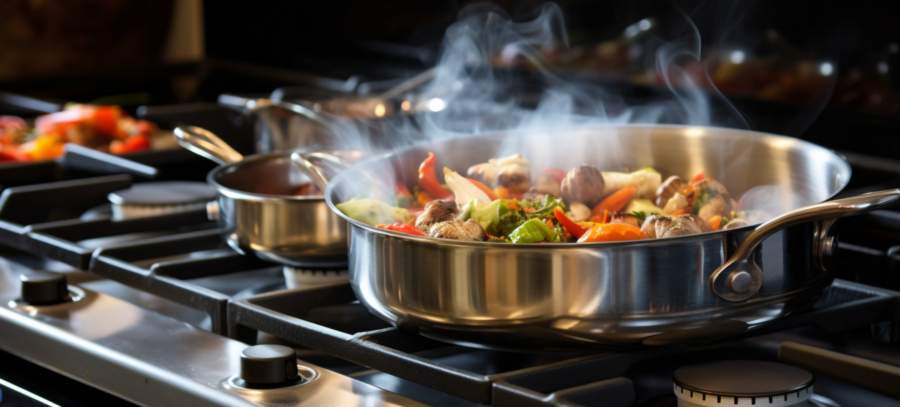Energy-Wise Cooking: Saving in the Kitchen

Introduction: The Unseen Battle for Energy Efficiency
There exists, in our very homes, an unseen war. Not the silent battle between the last two cookies in the jar, nor the eternal struggle between your in-laws and your sanity. No, this is a war of energy consumption, waged daily in our kitchens. The time has come to claim victory, my friends, and to do so, we must become energy-wise cooks! Behold, I present you with numerous insights and practical advice to become a culinary eco-warrior. Let us embark on this delicious and energy-efficient journey!Choose Your Weapon Wisely: Cookware and Appliances
Before one can partake in the art of energy-wise cooking, one must be armed with the proper tools. For instance, one should consider the humble pot or pan. A flat-bottomed, well-fitting cookware shall ensure optimal contact with the heating element, allowing for faster and more thorough cooking. Cast aside the warped and uneven-bottomed vessels, for they are but energy-thieves in disguise!Furthermore, be wise in selecting your heat-generating allies. The microwave, a marvel of modern technology, can heat food using a fraction of the energy required by its stove-top or oven counterparts. Favor the slow cooker, which gently simmers your meal to perfection with minimal energy usage. And let us not forget the pressure cooker, a fearsome beast that cooks at lightning speed, using its elevated pressures to slash cooking times and energy consumption.
Mastering the Elements: Efficient Use of Heat
Having armed oneself with the proper tools, one must now learn to wield them with skill and precision. When using electric stoves, match the pot size to the burner size, or risk letting precious energy escape into the ether. For gas stoves, adjust the flame so it does not lick up the sides of the pot, lest your culinary masterpiece be tainted with the taste of burnt energy waste.Do not shy away from utilizing residual heat, for it is a powerful force in the hands of an energy-wise cook. Instead of turning off the oven or stove a few minutes before the food is done, let the lingering heat finish the cooking process. Truly, it is like harnessing the embers of a dying fire to roast one last marshmallow before the flames are no more.
Preemptive Strikes: Defrosting and Prepping
Energy-wise cookery is not merely about the act of cooking itself, but also the strategy involved in preparing the meal. Firstly, thou must plan ahead and defrost your foods in the refrigerator instead of using the microwave or running water. This may take longer, but it allows you to strike a victory against energy waste with minimal effort.Secondly, employ clever tactics to minimize cooking time. Cut your ingredients into smaller pieces, or start the cooking process with hot water from the tap or kettle. With each battle won in the name of shorter cooking times, you shall be one step closer to achieving ultimate energy efficiency in the kitchen.
The Great Cover-Up: Lids and Seals
Just as a knight dons his armor in preparation for battle, so too must your pots and pans be equipped with their appropriate covers. By using tight-fitting lids, heat shall be trapped, cooking times shortened, and energy conserved. When using the oven, avoid repeatedly opening the door, lest the heat escapes and your energy savings crumble like a poorly-baked soufflé.Additionally, ensure the maintenance of your appliances by regularly checking and replacing worn seals. A leaky refrigerator door, much like a double agent, may appear to be on your side, but is secretly sabotaging your energy-saving efforts.
Adapting to Your Environment: Seasonal Cooking
Finally, embrace the changing of the seasons and the bounty they provide. Cooking seasonal produce not only supports local farmers and provides fresher, tastier ingredients, but also reduces the energy footprint associated with transportation and storage of out-of-season items. Plus, the variety of seasonal recipes shall keep your taste buds entertained and your culinary skills ever-sharpened.- Spring: Asparagus, peas, and tender greens
- Summer: Juicy tomatoes, bell peppers, and corn
- Fall: Root vegetables and hearty squashes
- Winter: Cabbage, kale, and citrus fruits
Latest Articles
- Why Your Showerhead Is Suffering From a Mineral Midlife Crisis
- Gateways That Turn Heads While Keeping Your Property Safe
- Listening Pipes: Using Sound to Diagnose Hidden Home Plumbing Issues
- Small Changes That Make a Kitchen Feel Completely New
- Scents That Refuse to Leave and How to Outwit Them
- How Personalisation Makes Homewares Feel Special
- Asphalt Advantage and the HOA Budget Balancing Act
- The Step-By-Step Process of Turning a Garden Vision into Reality
- Rain Doesn't Fall Straight: Why Roof Shape and Wind Matter More Than You Think
- How Fire Pit Design Quietly Shapes Human Connection
- Invisible Passengers Who Never Pay the Fare
- When the Ground Has Opinions: Learning to Hear Tree-Soil Conversations
- When Windows Sweat: What Condensation Reveals About Your Home's Hidden Climate
- Vertical Micro-Oasis for Kitchen Herbs in Tight Urban Spaces
- Why Clean Workspaces Quietly Boost Creativity
- Color-Coding Your Backyard: a Homeowner's Guide to Safe DIY Marking
- Invisible Safety in Bathrooms that Still Feel Like a Spa
- How Orientation Shapes Your Extension's Energy Efficiency
- How Floor Patterns Change How a Room Is Perceived
- Angles, Curves and the Secret Life of Staircases
- Interior Design
- Home Improvement
- Gardening
- Home Organization
- Home Maintenance
- DIY Crafts
- Kitchen and Dining
- Bathroom Design
- Home Security
- Home Automation
- Green Living
- Home Office
- Home Decor
- Garden Design
- Pet Care
- Home Technology
- Landscaping
- Home Energy Efficiency
- Home Cleaning
- Home Safety
- Home Exterior
- Home Insulation
- Home Buying
- Home Selling
- Renting
- Tradespeople
- Garage
- Bedroom
- Painting and Decorating
- Plumbing and Drainage

